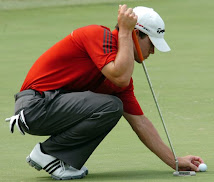1. 430yds, par four: a severe dogleg right where a more aggressive tee shot requires great precision with both distance control and angle. The putting green, sloped at the front, is very narrow.
2. 389yds, par four: dogleg left this time with a green perched up on a ridge and a relatively flat surface offering the chance of birdie.
3. 232yds, par three: new back tee makes this the longest of the par threes. Green is set at an angle and recovery shots require a great touch as the green falls off in all directions.
4. 517yds, par five: since the 2002 US Open the area behind the green has been changed to make it less likely that shots roll down the steep hill. Trees behind the green have also been removed.
5. 478yds, par four: downhill drive to a fairway that sits at a slight left-to-right angle. Large overhanging oaks are left of the hole and the relatively small green sits on a ridge.
6. 408yds, par four: the green sits some 50 feet below the drive zone, but the hillside is now fairway and that allows for the option of driving to the bottom and leaving a short pitch.
7. 525yds, par four: longer by 36 yards, it becomes the longest par four in US Open history. The fairway has been widened substantially on the right, but large oaks protect the corner of the dogleg right.
8. 230yds, par three: the green now comes right up to the pond at the front and there are plans to mix up the yardage right down to 135 yards. Could be anything from pitching wedge to long iron.
9. 460yds, par four: a new tee is 40 yards back and with an added fairway bunker most approach shots will be played from a severely sloping lie to a green that is mostly blind. Unlikely to be the easiest par four it was in 2002.
10. 508yds, par four: deep bunkers guard both sides of the drive zone, but the fairway has been brought back closer to the tee because of problems at the last US Open. Length will still be a factor as the green is fronted by bunkers and a deep swale.
11. 435yds, par four: like the 10th this hole is out in the open and exposed to the winds. The fairway is somewhat blind with deep bunkers guarding both sides and the green is one of the most difficult, sloping steeply from back to front.
12. 504yds, par four: this played as the second hardest in the 2002 US Open. Play safely to the right of the deep cross-bunker and leave yourself a long approach or try for a 260-yard carry. The prevailing wind is against and the green has a pronounced tier.
13. 605yds, par five: the only par five on the back nine has a new teeing ground some 50 yards back and also new deep bunkers left of the drive zone. Two good shots will set up a birdie chance, but one miscue could create real problems.
14. 158yds, par three: the green has been enlarged and allows three new hole locations, including one on a new front-left tongue. A new back tier also requires precise distance control.
15. 458yds, par three: slight dogleg which could again prove the toughest hole. The green is perched some 50 feet about the fairway and is without a doubt the scariest on the course. Two-tiered and slopes severely from back left to front right.
16. 490yds, par four: played from high up on a teeing ground that overlooks the entire hole, but the green is guarded by deep bunkers that partially obscure the view on approach shots and has bowl-like features on the right and left.
17. 207yds, par three: the hourglass-shaped green is mostly blind from the teeing ground, has two distinct tiers and is surrounded by deep bunkers. As in 2002 it will have a stadium-like feel, with two large grandstands on the sides and a hillside for fans behind.
18. 411yds, par four: either lay up short of the deep cluster of bunkers on both sides of the drive zone or be more aggressive and attempt to drive between or beyond them. The uphill approach is played to a blind putting surface.
Wednesday, 17 June 2009
Subscribe to:
Posts (Atom)

